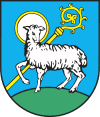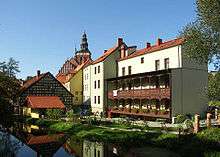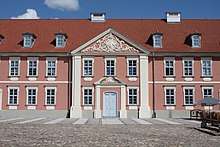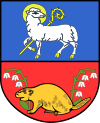Lidzbark Warmiński
Lidzbark Warmiński ([ˈlʲid͡zbarɡ varˈmʲiɲskʲi] (![]()
![]()
Lidzbark Warmiński | |
|---|---|
 Castle of Warmian Bishops | |
 Coat of arms | |
 Lidzbark Warmiński  Lidzbark Warmiński | |
| Coordinates: 54°7′N 20°35′E | |
| Country | |
| Voivodeship | |
| County | Lidzbark |
| Gmina | Lidzbark Warmiński (urban gmina) |
| Established | before 1240 |
| Town rights | 1308 |
| Government | |
| • Mayor | Jacek Wiśniowski |
| Area | |
| • Total | 14.34 km2 (5.54 sq mi) |
| Population (2006) | |
| • Total | 16,390 |
| • Density | 1,100/km2 (3,000/sq mi) |
| Time zone | UTC+1 (CET) |
| • Summer (DST) | UTC+2 (CEST) |
| Postal code | 11-100 to 11-102 |
| Area code(s) | +48 89 |
| Car plates | NLI |
| Website | Lidzbark.pl |
Lidzbark Warmiński was once the capital of Warmia and formerly its largest town. Lidzbark itself was a religious and cultural center, for which it was known as the Pearl of Warmia. For a long period of time it was under the control of the Warmian Bishops and it was also a major economic center, only resigning its importance to the nearby city of Braniewo.
The Warmian Bishop's Castle is considered to be a great artistic and historical value in the world and has been recognised as a historical monument by the Polish government.
History

The town was originally an settlement of Old Prussians known as Lecbarg until being conquered in 1240 by the Teutonic Knights, who named it Heilsberg.[1] In 1306 it became the seat for the Bishopric of Warmia (Ermland), and remained the Prince-Bishop's seat for 500 years.[1] In 1309 the settlement received town privileges. After the Second Peace of Thorn (1466) weakened the Teutonic Order and ended its claim to the area, the town was integrated into the Polish province of Royal Prussia.
Nicolaus Copernicus lived at the castle for several years, and it is believed he wrote part of his De revolutionibus orbium coelestium there.
In the winter of 1703–04 the town was the residence of King Charles XII of Sweden during the Great Northern War.
The town was annexed with the rest of the region by the Kingdom of Prussia in the First Partition of Poland in 1772. In 1807 a battle took place near the town between the French under Joachim Murat and Nicolas Jean de Dieu Soult and the Russians and Prussians under Levin August, count von Bennigsen.[1]
From 1933 to 1945 it was the site of the large German government radio station Transmitter Heilsberg. The town was heavily damaged after its conquest by the Soviet Red Army during World War II in 1945. As part of territorial changes demanded by the Soviet Union at the Potsdam Conference, the town became part of Poland, and was gradually resettled by Poles, many of them from the parts of eastern Poland annexed by the Soviet Union.
Education

- Wszechnica Warmińska, founded on 21 May 2004
- Comprehensive Schools im. Kazimierza Jagiellończyka
- Trade Schools im. Stanisława Staszica
- Farner School
- Primary School No. 1 im. Mikołaja Kopernika
- Primary School No. 3 im. Ignacego Krasickiego
- Primary School No. 4 im. Jana Pawła II
- High/grammar School No. 1
- High/grammar School No. 2
- National Music School I Level
- Non-Public Kindergarten No. "Kubuś"
- Non-Public Kindergarten No. "Miś"
- Non-Public Kindergarten No. "Puchatek"
- Public Kindergarten No. 5
- Public Kindergarten No. 6
Twin towns – sister cities
Lidzbark Warmiński is twinned with:




Famous people
- Mauritius Ferber (1471–1537) member of the patrician Ferber family and Roman Catholic Prince-Bishop of Warmia (Ermeland)
- Nicolaus Copernicus (1473–1547), famous astronomer, mathematician, physician, and canon
- Stanislaus Hosius (Stanisław Hozjusz) (1504–1579), Polish Roman Catholic cardinal, Prince-Bishop of Warmia
- John Albert Vasa (Jan Albert Waza) (1612–1634), Polish cardinal, Prince-Bishop of Warmia and Kraków,
- Teodor Andrzej Potocki (1664–1738) Prince-Bishop of Warmia, Primate of Poland, interrex in 1733
- Ignacy Krasicki (1735–1801), Prince-Bishop of Warmia, Primate of Poland, Polish poet
- Ernst Burchard (1876–1920), doctor and scientist
- Dorothee Raetsch (born 1940), German sculptor and graphic artist
- Zbigniew Mikołejko (born 1951), Polish philosopher and historian of religion, essayist
References
- Chisholm, Hugh, ed. (1911). . Encyclopædia Britannica. 13 (11th ed.). Cambridge University Press. p. 212.
External links

- https://web.archive.org/web/20171030132939/http://www.lidzbark.com/ (in Polish)
- https://web.archive.org/web/20040223142519/http://www.lidzbarkwarminski.pl/ (in Polish)
- https://web.archive.org/web/20050110174133/http://www.warmia-mazury.pl/powiaty/lidzbark.html (in Polish)
- Map of Warmia Catholic Diocese in 1755
- https://web.archive.org/web/20171010080701/https://www.heilsberg.org/ (in German)
